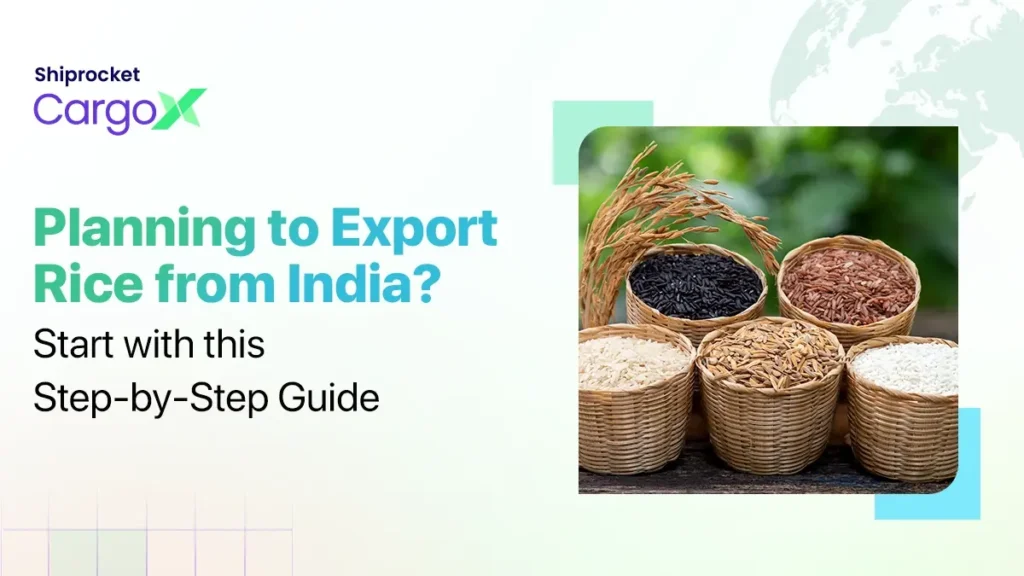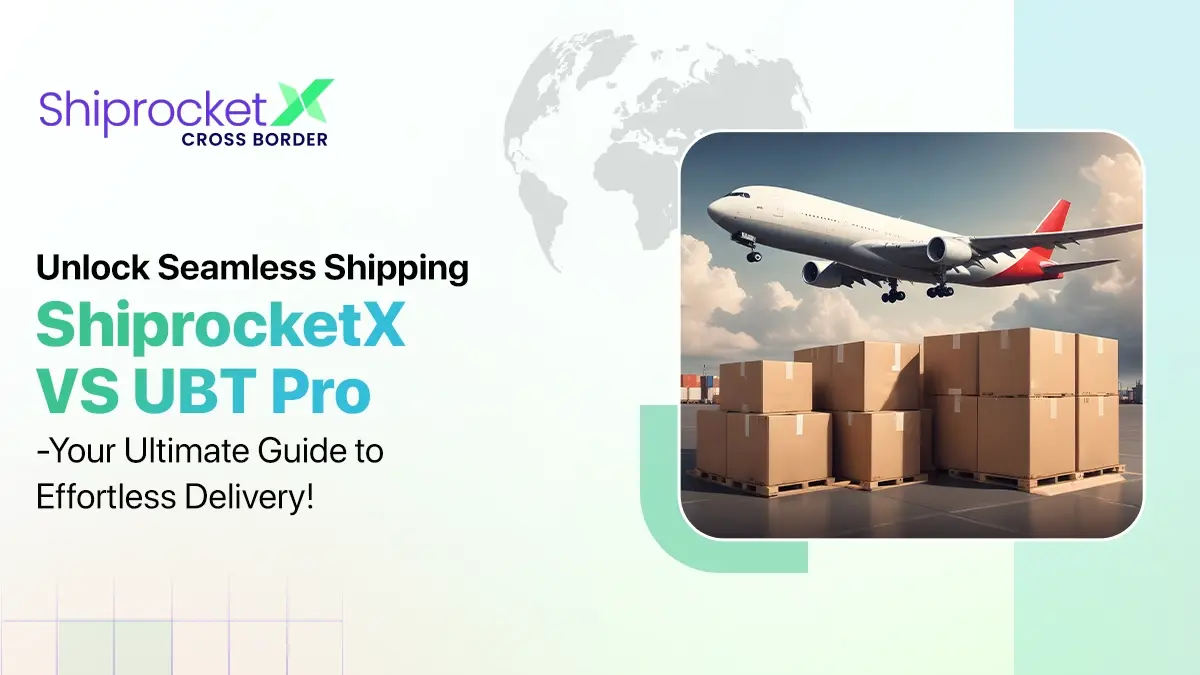How to Export Rice from India: Step-by-Step Guide
- Getting Started with Rice Exports
- Step-by-Step Breakdown of the Rice Export Process
- Step 1: Do some market research
- Step 2: Register your business
- Step 3: Open a current account
- Step 4: Apply for the IEC code
- Step 5: Register with APEDA
- Step 6: Get your FSSAI license
- Step 7: Apply for GST
- Step 8: Finalise your supplier
- Step 9: Plan your packaging
- Step 10: Prepare your documents
- Step 11: Book your shipment
- Step 12: Check if export duty applies
- Legal Compliance and Licences for Rice Export
- Top Global Importers of Indian Rice
- Top Rice Exporting Countries: Where India Stands
- Most Popular Indian Rice Varieties in Global Markets
- How CargoX Streamlines Global Rice Shipping from India
- Conclusion
The export of Basmati rice is on the rise. Countries such as those in the Middle East, Africa, and parts of Asia regularly import Indian rice due to its high quality and variety. Starting a rice-export business can feel confusing, but it becomes more manageable once you understand the process. Every market has different rules, preferences, and packaging requirements. So, before you begin, it’s essential to get the basics right. This guide will help you understand what’s needed to start a rice export business.

Getting Started with Rice Exports
If you plan to export rice, here’s how most sellers usually begin. Start slow, get the basics right, and build from there.
The first thing many sellers do is research. It is helpful to know which countries are importing rice, what varieties are in demand, and how buyers prefer their orders, such as grain type, packaging size, or quality standards. Look into trade data, recent export trends, and which certifications or licenses are usually required in those markets.
This early research helps clarify pricing, competition, and customer expectations. Understanding this upfront can save you time later and help you plan more effectively. Once you’re clear on where and what to export, it becomes easier to set the rest.
Step-by-Step Breakdown of the Rice Export Process
Here is a step-by-step guide to get you started:
Step 1: Do some market research
Before jumping in, take some time to check which countries are buying rice, the type they prefer (such as basmati, non-basmati, or parboiled), and how they want it packed. Also, check if exporting these types requires any special certificates. This helps avoid confusion later.
Step 2: Register your business
You need a proper business setup. It can be a sole proprietorship, a partnership, or a private limited company, whichever works best for you. Ensure your business has a PAN card registered in its name.
Step 3: Open a current account
This is where you’ll receive payment from your buyers. The account must be in your business name and should support international transactions.
Step 4: Apply for the IEC code
This is a 10-digit code that allows you to export. Without it, you can’t ship anything abroad. You can apply online through the DGFT, and the process usually doesn’t take very long.
Step 5: Register with APEDA
Since rice is a food product, APEDA registration is compulsory. Once you get registered, you’ll receive a certificate. If you’re exporting basmati, you must register your contract every time.
Step 6: Get your FSSAI license
This proves that your rice meets food safety standards. Many international buyers ask for it, so it’s better to get it early on.
Step 7: Apply for GST
Even though exports are zero-rated under GST, having a GST number is still compulsory. You’ll also need it to claim any input tax credit or refund later.
Step 8: Finalise your supplier
Ensure that the rice supplier or miller you work with is reliable and consistently provides the same high quality in every batch. A bad batch can spoil your relationship with a buyer right at the start.
Step 9: Plan your packaging
Rice requires strong and clean packaging that can withstand long-distance travel. Bags should be properly sealed. The label should clearly indicate the type of rice, its origin, weight, and any other details the buyer requests.
Step 10: Prepare your documents
Some documents are non-negotiable. You’ll need:
● Invoice
● Packing list
● Phytosanitary certificate
Some buyers or countries may request additional documentation. Confirm this before shipping.
Step 11: Book your shipment
You can choose sea or air transport, depending on the order size. Don’t forget to get insurance. It protects you if anything gets damaged or delayed.
Step 12: Check if export duty applies
India has imposed an export duty on certain types of rice, including parboiled non-basmati rice. These rules are subject to change, so please check for the latest update before shipping.
Legal Compliance and Licences for Rice Export
If you’re planning to export rice from India, there are several legal requirements to consider:
● Start with the Importer Exporter Code (IEC). This is the first thing. Without it, you can’t export anything. You can apply for it online through DGFT.
● Next, get GST registration. Although GST doesn’t apply directly to exports, having a GSTIN is still mandatory. You’ll need it for tax records and refund claims.
● Now, register with APEDA. This is the main body responsible for handling rice exports. Once you register, you’ll get an RCMC certificate to claim benefits and complete paperwork.
● If you’re exporting basmati rice, you’ll have to register each export contract with APEDA before shipping.
● Get your FSSAI license too. Many international buyers request it to ensure your rice meets food safety standards. It’s better to apply early.
● Ensure your rice passes quality checks. The Export (Quality Control and Inspection) Act of 1963 states that rice must meet specific standards before being exported from the country. This includes packaging, grading, and labelling rules.
● Here are a few more documents you’ll need before shipping:
- A phytosanitary certificate to show the rice is pest-free.
- A certificate of origin to prove it’s grown in India.
- A commercial invoice with proper value and buyer details.
● Also, keep an eye on any export duties or restrictions. These changes vary depending on the rice variety or policy. If everything is in place, you’re legally ready to ship rice from India.
Top Global Importers of Indian Rice
If you’re getting into rice export, it helps to know where Indian rice is in high demand. Some countries have been steady buyers for years, while others are experiencing rapid growth. Here’s a quick look at the main markets:
- Saudi Arabia: This country has a big appetite for Basmati rice. The population is growing, and so is the demand, both in homes and large food businesses. Indian Basmati is preferred for its distinctive aroma and long, slender grains.
- United Arab Emirates (UAE): A large number of Indians live in the UAE, so the demand for Indian rice, both Basmati and non-Basmati, is always high. Restaurants and grocery stores regularly restock it, so shipments move frequently.
- Iran imports a significant amount of rice from India due to its high quality and competitive prices. Due to international restrictions, there are fewer suppliers they can trade with, and India remains one of the main ones.
- Iraq: Iraq has become a fast-growing buyer of Indian rice. The country’s supply is insufficient, so it regularly imports Basmati rice from India to fill the gap.
- Benin: Benin is a regular buyer of Indian non-Basmati rice. What’s interesting is that a significant portion of the rice sent to Benin is further distributed to nearby countries in Africa.
- Bangladesh: With such a large population, Bangladesh needs rice for daily consumption and government food programs. Since it borders India, sending rice from places like Bihar and Bengal is quick and low-cost.
- Nepal: Nepal depends heavily on Indian rice, both Basmati and non-Basmati. It’s one of their staple foods. Due to the open border and good relations, trade flows smoothly.
- Nigeria: Nigeria is one of Africa’s biggest rice markets. Even though it’s far, Indian exporters have made their place here. Both rice varieties are in demand due to changing lifestyles and food habits.
- South Africa: Indian rice is popular in South Africa due to its affordability and ease of cooking. It’s used in homes and restaurants. Because of its quality and price, Indian rice is a regular part of their imports.
Top Rice Exporting Countries: Where India Stands
Here are the top exporters of Rice in the world:
- India: India exports approximately 22 million metric tonnes of rice annually. That includes both Basmati and non-Basmati. Buyers across Asia, Africa, and the Middle East prefer Indian rice because it is affordable, readily available in bulk, and suits the tastes of many local populations.
- Thailand: Thailand comes second with about 7.5 million metric tonnes. Their jasmine rice is in demand, but their volume is still far behind India’s.
- Vietnam: With approximately 6 million metric tonnes, the majority of its rice is marketed in Asia and certain regions of Africa.
- Pakistan: 5.3 million metric tonnes of rice are exported from Pakistan. It exports a lot of Basmati rice.
- Cambodia: After Pakistan, Cambodia exports 3.4 million metric tonnes.
- The United States: The US exports over 2.95 million metric tonnes a year. Most of it goes to Latin America and a few other regions. They mainly sell medium and short-grain rice.
Most Popular Indian Rice Varieties in Global Markets
When it comes to what sells best abroad, basmati rice, especially Pusa Basmati 1121, is hugely popular due to its extra-long grains, fluffy texture, and fragrant aroma. It’s used in biryani and pilaf and is a favourite in the Middle East, Europe, Africa, and the US. It makes up roughly 70% of India’s total Basmati exports.
It is drought-resistant, photo-insensitive, and gives better yields than traditional Basmati. India exported about 52.4 lakh tonnes of Basmati rice in 2023-24. Major buyers include Saudi Arabia, the UAE, and the USA.
How CargoX Streamlines Global Rice Shipping from India
If you’re a seller sending bulk orders abroad, CargoX can make things much easier. You can complete everything in one location, rather than handling multiple tasks such as checking shipments, paperwork, and finding couriers.
You don’t need to worry about where your shipment is or if it’s delayed. CargoX gives full tracking, clear billing, and easy paperwork. No hidden charges, no last-minute surprises. It saves you both time and stress.
Conclusion
If you’re planning to export rice, especially basmati, from India, it’s essential to begin with the right groundwork. Though the demand is strong, your success depends on how well you prepare in the beginning.
Spend some time understanding what global consumers want and how the export process works. And once you know the basic concepts, everything starts to fall into order. Start with small steps to avoid mistakes and establish a solid foundation for your export company.






